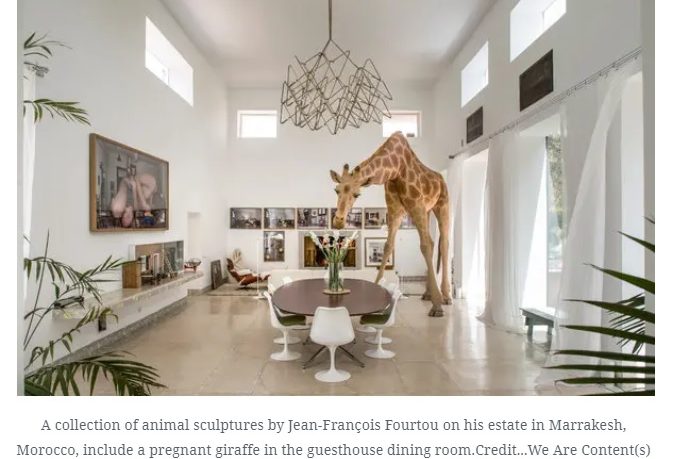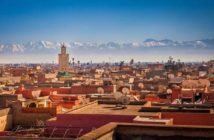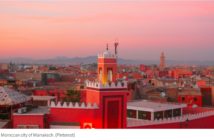By Aida Alami
Jean-François Fourtou has seen Marrakesh undergo rapid change in recent years, as it has become an increasingly popular tourist destination.
His 25-acre estate, Dar El Sadaka, which was once isolated from the city, is now surrounded by development, including hotels and other private homes.
Still, the peacefulness has been preserved at a property where Mr. Fourtou, a French artist known for his sculptures of animals — predominantly lambs, giraffes, snails and orangutans — has spent two decades channeling his creative impulses.
What was once a large parcel of land dotted with ruins has been transformed into lush gardens of olive and palm trees, a guesthouse with nine suites and bedrooms, an open-air gallery, a meditation retreat and an art studio, as well as Mr. Fourtou’s own home. His whimsical sculptures and architectural works of art are dotted throughout.
Mr. Fourtou occasionally allows tours, which must be booked in advance, and he has opened his property during art events such as the Marrakesh Biennale. To finance the maintenance of the estate, the guesthouse is available for rental for $3,800 a day for up to 20 guests. The minimum stay is three nights.
But Mr. Fourtou isn’t interested in competing with popular Marrakesh attractions like the Majorelle Garden, which draws 700,000 visitors a year. He believes that letting in large groups of tourists would alter the estate’s magic.
Dar El Sadaka means the house of friendship in Arabic or the one who searches in Sanskrit. The whole estate is a metaphor for Mr. Fourtou’s childhood.
The sculptures of animals, disconnected from their natural environments, are meant to illustrate how out of place the artist felt growing up in Paris. “They represent how I pictured myself within society,” he said on a tour one late summer afternoon.
Past the gates, on the left, a two-story house is built upside down, standing on its roof with the sign “Chez Grand-Père” hanging over the front door. It was inspired by Mr. Fourtou’s memory of the house of his late maternal grandfather in southwestern France.
“I imagine that he sent it to me from above, 30 years after he died,” Mr. Fourtou said, recalling how his grandfather drew him postcards and told him stories that stimulated his imagination and encouraged him to express his creativity at an early age.
Each corner of the estate holds a different surprise. A wide staircase leads to the so-called Giant’s House. Inside, there is a large table, a bed, a closet and clothes. As happens inside the upside-down house, one’s senses are thrown off balance.
“The idea is that those who get to see my work are destabilized and experience incongruent situations,” said Mr. Fourtou. “It is a chance to feel forgotten childhood feelings. I do not really offer a stay, but rather an experience.”
For overnight guests, meals are usually made using organic produce, honey and olive oil cultivated on the property. Most of the rooms are spacious and have beautiful views of the garden. The guesthouse was renovated a few years ago by the interior designer Philippe Forestier, and details like the scents, the lighting and the linens have been carefully thought out.
The house is also filled with Mr. Fourtou’s artwork and his signature productions: extremely realistic and detailed sculptures of animals. Each of the nine bedrooms is itself an artistic installation conceived around a different animal.
In the large dining room, a pregnant giraffe stands over an expansive table. It was originally designed for Mr. Fourtou’s penthouse loft in SoHo, New York City, before being transported through Madrid and finally completed in Morocco. Orangutans are perched on the living room lamps and there is a giant sheep beside the swimming pool.
The sculptures are difficult to create, Mr. Fourtou said. The work is tedious because every part of each piece is meticulously researched and designed, a process that can take months or even years. Mr. Fourtou, a graduate of the Beaux-Arts school of art in Paris, works in his onsite studio with the help of local designers.
“To disturb the visitor, I often change the scale to much larger or much smaller,” Mr. Fourtou said. “Never ferocious animals. But often sheep, or a pregnant animal wedged in a room in order to make them even more fragile.”
Mr. Fourtou spends about half the year in Marrakesh, when he’s not visiting his teenage daughter in Paris or roaming other parts of the world like Greece or India.
He doesn’t enjoy the Marrakesh social scene and keeps a pretty austere routine involving meditation, swimming and hours in his studio working on projects for private collectors or big fashion houses like Hermès, for whom he has designed storefronts in Paris and Tokyo. He is also creating sculptures of butterflies for his house in Madrid.
The estate has been an ideal location for him to fulfill his need for a spacious and quiet space to work, he said, while also balancing it with his family life.
On the other side of the rectangular property is the home where Mr. Fourtou lives with his husband, Pascal, and their two small children.
That building, La Maison Ruche, or the House of Beehive, has a panoramic view of the garden and is full of wonders that include hidden compartments, secret doors and beds nestled in hidden closets. Some of the floors are made of traditional Moroccan zellige tiles, and oversized bees hang on the ceilings. The basement has its own secrets: a mazelike series of rooms that contain a massage parlor and a traditional hammam, or Turkish bath.
Over the years, Mr. Fourtou said, he realized that he was much more comfortable in the countryside than he had ever been in a city.
“Once I settled here, it gave me back every effort I put into building it,” he said of the estate.
The plot where he built Dar El Sadaka was initially bought by Mr. Fourtou’s father, Jean-René Fourtou, the former chief executive of the French media group Vivendi Universal (now Vivendi), in 1995.
Major restoration work was needed, and at the time it was hard for foreigners to navigate Moroccan bureaucracy to get construction permits.
What was supposed to be a monthslong project to help his father turned into a yearslong program of artistic creation and expansion that is far from over.
“I feel that I am never finished and that I am constantly in search of something,” Mr. Fourtou said. “The place is not frozen in time. It doesn’t just belong to me but I am inviting each visitor to make the experience their own.”







